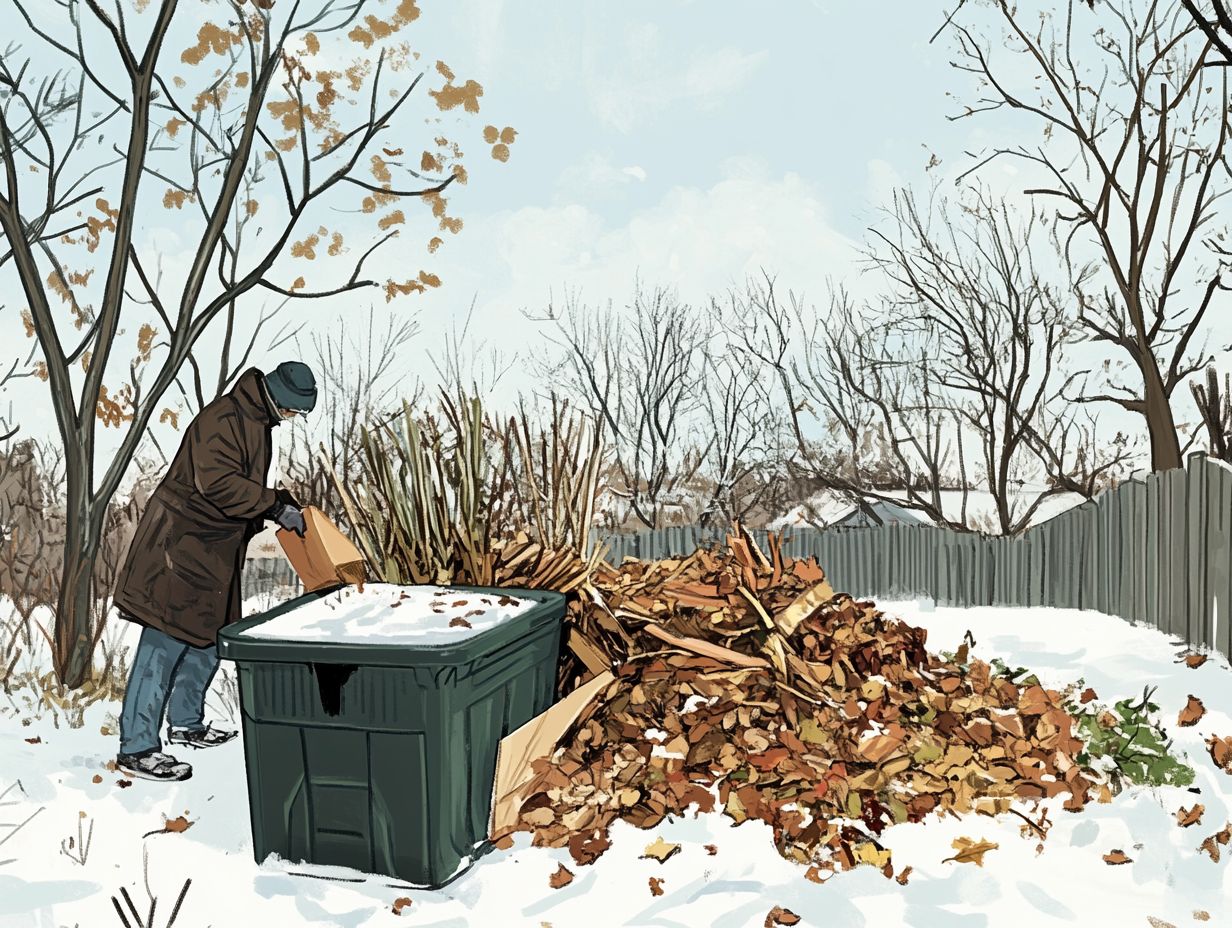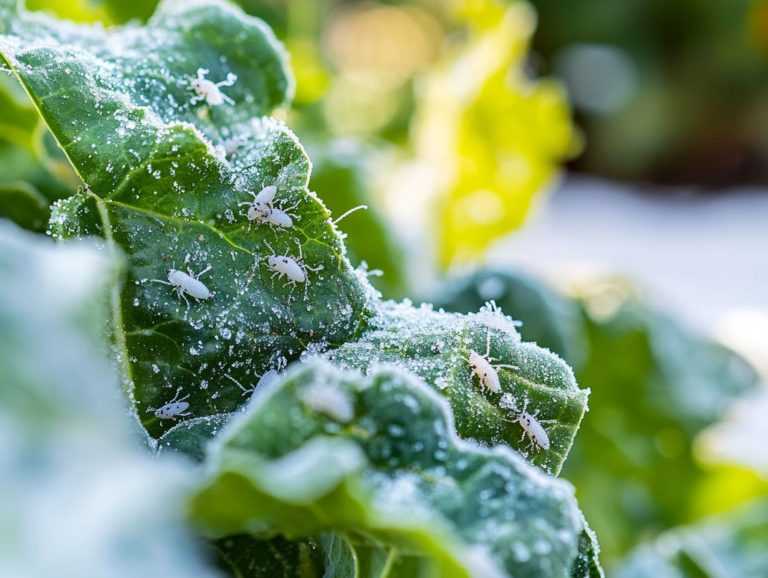Best Practices for Composting in Cold Climates
Composting in cold climates can indeed present unique challenges. Yet, with the right strategy, you can unlock remarkable benefits.
In this article, you ll discover essential methods for successful winter composting. You ll learn how to select the most effective technique for your environment, prepare your compost pile for harsh conditions, and maintain optimal temperatures.
You ll also find best practices for utilizing finished compost and troubleshooting common winter-related issues.
Whether you re a seasoned gardener or an eager novice, get ready to transform your composting game during winter!
Contents
- Key Takeaways:
- Understanding Composting in Cold Climates
- Choosing the Right Composting Method
- Preparing for Winter Composting
- Managing the Compost Pile in Cold Weather
- Using Compost in Cold Climates
- Troubleshooting Common Issues
- Frequently Asked Questions
- What are the benefits of composting in cold climates?
- What are the best materials to use for composting in cold climates?
- How should I maintain my compost pile during the winter?
- Can I compost during the winter?
- What are some common mistakes to avoid when composting in cold climates?
- Are there any alternative methods for composting in cold climates?
Key Takeaways:

- Properly preparing for winter composting is crucial in cold climates to ensure effective breakdown of materials and avoid common issues.
- Pick the right method and keep an eye on the temperature for successful composting in cold weather.
- When using compost in cold climates, apply and store it correctly to maximize its benefits for plants and the environment.
Understanding Composting in Cold Climates
Composting in cold climates, especially in places like Ontario, Canada, introduces unique challenges and opportunities that can greatly influence your composting success. To navigate these conditions effectively, consider exploring winter composting tips for cold climates.
The chill in the air can slow down the breakdown of materials. This means selecting the right composting strategies is crucial for managing organic matter such as food scraps, fallen leaves, and kitchen waste.
With diligent compost maintenance, you can still produce nutrient-rich compost even during winter, ensuring that none of those valuable materials go to waste in this frosty season.
Challenges and Benefits
Winter composting presents a unique blend of challenges and benefits that you need to grasp to enhance your composting practices.
One primary hurdle in colder months is maintaining the right temperature. As the chill sets in, the breakdown of materials tends to slow significantly, leading to issues like incomplete decomposition and even a risk of animal intrusion. This makes it crucial for you to implement ways to keep animals away to safeguard your precious organic matter.
Despite these challenges, notable advantages exist, such as the potential for nutrient preservation. When managed correctly, winter compost can produce high-quality compost that beautifully enriches your garden soil. By comprehending both the obstacles and benefits, you can fine-tune your winter composting efforts for optimal results.
Choosing the Right Composting Method
Selecting the ideal composting method is essential, particularly in colder climates where traditional practices might not deliver the same results. Understanding the benefits of using compost in cold climates can make a significant difference.
As a gardener in Ontario, Canada, consider using a compost tumbler for rapid breakdown of materials, exploring vermicomposting with earthworms for nutrient-rich compost tea, or opting for Bokashi composting (a method that uses fermentation) for swift processing.
Each method brings its own distinct advantages, so evaluate which one best aligns with your lifestyle and composting objectives.
Assessing Climate and Available Resources
Assessing your climate and available resources is essential for selecting the most effective composting method tailored to your needs.
Understanding local weather patterns whether you re in a dry, arid environment or a humid, rainy one is significant in determining optimal composting techniques for your situation.
For example, if you find yourself in a wetter climate, a compost bin that shields against excess moisture might serve you best. Meanwhile, arid regions could benefit from open piles that encourage aeration.
The materials you have at your disposal, such as kitchen scraps, yard waste, and brown materials like leaves, combined with the space you can dedicate to composting, are crucial for maintaining an efficient process.
Having the right equipment, including aerators and thermometers, is also invaluable. These tools help you monitor the compost’s progress, ensure the right balance of nitrogen and carbon, and facilitate proper decomposition.
Ready to start your winter composting journey? Dive in and discover how to make composting a success, even in the frostiest months!
Preparing for Winter Composting

Preparing for winter composting involves essential steps and tips. Understanding the benefits of composting in cold weather can enhance the efficiency of your compost bin during colder months.
Begin by ensuring that your compost bin is properly insulated to retain heat. This is vital for maintaining the decomposition process, especially when learning how to use compost in cold-weather gardening, even in freezing temperatures.
Layering carbon-rich materials, such as fallen leaves, with nitrogen-rich kitchen waste will further boost bacteria activity. Incorporating compost insulation or using a compost tumbler can facilitate aeration, improving the breakdown of organic matter.
Essential Steps and Tips
When you embark on winter composting, there are several essential steps to ensure your kitchen waste and other compost materials decompose successfully.
Understanding the balance between carbon-rich materials often called browns (like dried leaves) and nitrogen-rich materials (like fruit scraps) is crucial. Proper layering is vital; aim for a mixture where browns form the base and greens sit atop for optimum air circulation.
Maintaining adequate moisture levels is equally important. Compost that s too dry can bring the decomposition process to a standstill. Consider covering your compost pile with a tarp during snowfalls to retain moisture while still allowing for ventilation and heat generation.
Managing the Compost Pile in Cold Weather
Managing your compost pile during colder months requires a proactive strategy to keep the decomposition process lively, even in low temperatures. Keep a close eye on the temperature of your compost pile to ensure it stays lively!
Implementing strategies like regularly turning the pile and incorporating materials that retain heat can foster an optimal environment for thermophilic and mesophilic bacteria to flourish, ensuring your compost remains active even when the mercury takes a dip.
Monitoring and Maintaining Temperature
Monitoring and maintaining the temperature in your compost pile is crucial for successful decomposition during the winter months.
To effectively manage this, consider employing thermometers specifically designed for composting. These tools provide precise readings, giving you clear insights into how well your pile is heating up.
Pay attention to physical characteristics, like steam rising from the pile or a moist, crumbly texture; these signs can reveal a lot about the composting process.
The presence of thermophilic organisms is vital for speeding up decomposition. These organisms thrive at warmer temperatures, efficiently breaking down organic matter. By ensuring these optimal conditions, you encourage healthy bacteria activity and enhance the nutrient quality of your finished compost, ultimately paving the way for rich, fertile soil in your garden.
Using Compost in Cold Climates
Utilizing compost in cold climates offers unique opportunities and best practices to fully harness its benefits for your gardens and landscapes. For detailed strategies, check out how to build healthy soil in cold climates. When applied correctly during the growing season, compost can enrich your soil, promote vibrant plant growth, and enhance moisture retention.
Additionally, knowing how to store compost properly through the winter months is essential. This way, it remains usable and advantageous by the time spring rolls around. Master these techniques now, and your composting efforts will pay off big time come spring!
Best Practices for Application and Storage

Best practices for applying and storing compost can significantly enhance its effectiveness in improving soil health and supporting plant growth.
Employ optimal methods to ensure this rich organic matter enhances soil structure, moisture retention, and nutrient availability. Consider your soil type when applying compost. For sandy soils, mixing compost bolsters water retention. In clay soils, it improves air flow and drainage. Different plants may also require tailored techniques think top-dressing for perennials or mixing it into the planting hole for annuals.
Keep your compost nutrient-rich by storing it in a cool, dry place, ideally under cover. This protects it from rain and sunlight, which can deplete those valuable compost materials.
Troubleshooting Common Issues
Troubleshooting common issues in winter composting is essential for maintaining an effective composting system. This ensures your compost materials break down seamlessly even in the chill of winter.
If you re not careful, you might encounter problems like unpleasant odors, sluggish decomposition, or unwelcome visitors such as raccoons or squirrels.
By recognizing these potential challenges and adopting effective management techniques, you can enjoy a flourishing compost pile all winter long.
Solutions for Common Winter Composting Problems
Finding solutions for common winter composting problems can significantly boost your composting success and help maintain a thriving compost environment.
As the cold weather rolls in, tackle challenges like managing unpleasant odors, fending off pesky pests, and ensuring that decomposition stays on track. One highly effective strategy is to layer your ingredients thoughtfully, mixing green and brown materials to create a balanced ecosystem. Using odor-neutralizing agents, such as well-aged wood chips, can eliminate unwanted smells. Covering your pile acts as a barrier against unwelcome pests.
Regularly check moisture levels and insulate your compost bin to enhance the decomposition process, allowing for better heat retention even in frigid temperatures. Additionally, consider using soil amendments effective for cold climates as part of your strategies to become a winter composting pro!
Frequently Asked Questions
What are the benefits of composting in cold climates?
Composting in cold climates helps reduce waste, creates nutrient-rich soil, and saves money on fertilizer costs. For optimal results, consider following the best practices for plant care in cold climates.
What are the best materials to use for composting in cold climates?

The best materials for composting in cold climates include dry leaves, vegetable and fruit scraps, coffee grounds, and top composting tools for cold climates like shredded newspaper.
How should I maintain my compost pile during the winter?
During the winter, keep your compost pile insulated and moist. Cover it with a tarp or add water regularly.
Can I compost during the winter?
Yes, you can compost during the winter! While the process may be slower, it is still possible with the right techniques.
What are some common mistakes to avoid when composting in cold climates?
Common mistakes to avoid include using too many kitchen scraps, not insulating the compost pile, and not turning the pile regularly.
Are there any alternative methods for composting in cold climates?
Yes, alternative methods include vermicomposting, using a compost tumbler, or employing a hot composting system.
Start composting today to support your garden and the environment!






